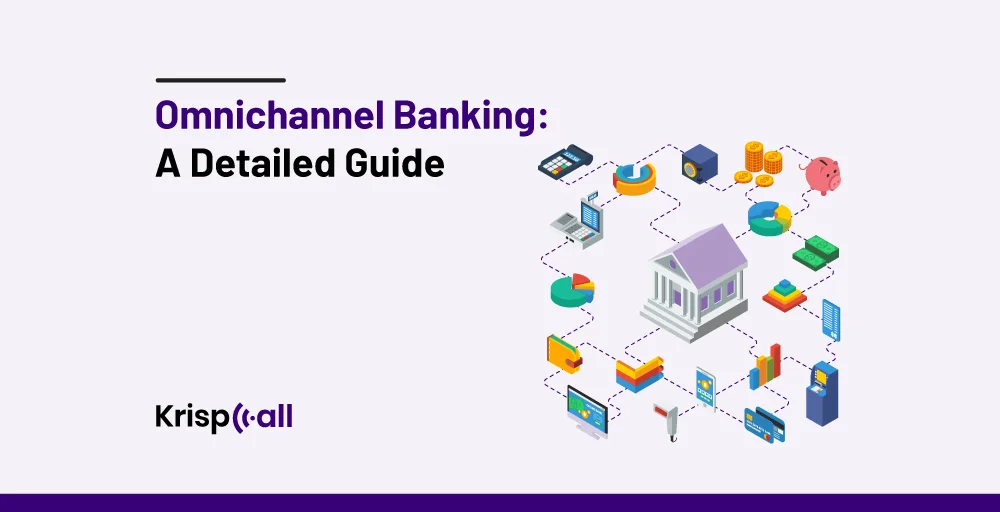Are you tired😫 of handling several banking websites and apps?
Imagine a world where your banking experience is smooth and consistent, no matter how you choose to interact with your bank. That’s where omnichannel banking comes in.
Omnichannel banking is a customer experience that is integrated across all customer touchpoints, including online, mobile messaging, in-person, phone, email, and video.
In this article, you will explore the fascinating world of omnichannel banking. This extensive overview will describe its main advantages, the difficulties it solves, and the cutting-edge features that will completely change the financial industry.
🔑 Key points
- Omnichannel banking offers a seamless and cohesive customer experience across all touchpoints, including online, mobile, in-person, and more. It enables efficient financial affairs management.
- It enhances the customer experience by providing consistency and convenience across all channels, ensuring customer transactions can be completed regardless of the chosen method.
- Omnichannel banking not only enhances security with robust authentication and encryption but also offers functionalities like remote check deposits, scheduling appointments with bankers, and accessing a wide range of financial services and advice through various channels.
- Omnichannel banking solutions are software and technology packages designed to help banks implement an omnichannel banking strategy.
- It empowers customers to choose how they interact with the bank while receiving a consistent and convenient experience.
What is omnichannel banking?
Omnichannel banking is a strategic approach that seamlessly integrates various customer touchpoints, including mobile messaging, online platforms, phone services, email communication, video interactions, and in-person visits.
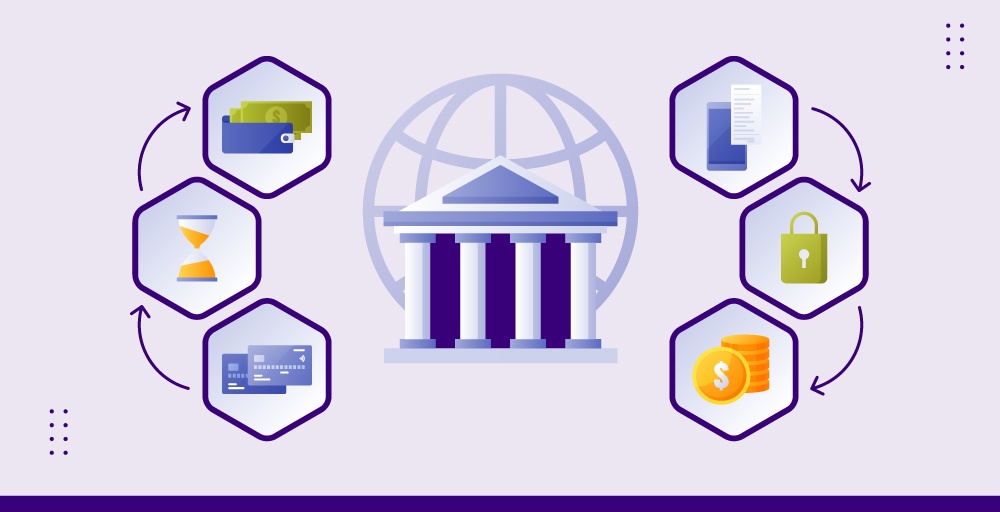
This cohesive strategy ensures a uniform user experience, enabling customers to efficiently manage their financial affairs and engage with their bank across any preferred digital channel.
Omnichannel banking aims to deliver a seamless and cohesive banking experience to customers across diverse channels provided by the bank.
This enables customers to seamlessly transition between the bank’s mobile app, online platform, branch network, and ATMs and even engage in real-time chats with customer service representatives. They can also seamlessly resume their interactions from where they left off.
For example, you can begin the loan application process on your phone by utilizing the bank’s mobile app. After that, you can use your laptop to finish the application and upload files. If you have any questions later, you can talk with a customer support agent on the bank’s website. All of this is made possible by omnichannel banking, which ensures your information is always accessible and the procedure is uniform.
What are the benefits of omnichannel banking?
Omnichannel banking offers several advantages for both financial institutions and their customers. Let’s explore these benefits:
- Enhanced customer experience: Online, mobile, phone and in-person interactions are just a few channels through which omnichannel banking offers a consistent and smooth experience. Regardless of the channel they use, customers can constantly complete banking transactions. This coordinated strategy guarantees convenience and consumer pleasure.
- Personalization: Omnichannel banking enables further personalization by utilizing data from several channels. To provide targeted promotions, tailored advice, and proactive communication, banks can examine the behavior, preferences, and transaction history of their customers.
- Flexibility: A true omnichannel platform can synchronize data in real-time, so customers can bank via various channels, including websites, mobile apps, in-person visits to branches, and other methods.
- Cost efficiency: Saving money is one benefit of putting an omnichannel approach into practice. Financial organizations may optimize operations and cut expenses by eliminating redundancies and simplifying procedures.
- Trust and human interaction: Omnichannel banking acknowledges the value of human connection even as it offers is the convenience of digital channels. Personalized service fosters trust, and clients like being able to speak with a live person when necessary.
How is omnichannel banking different from multichannel banking?
The main distinction is the combination of omnichannel and multichannel banking. While multichannel banking gives members and consumers various ways to interact with their FI and complete transactions, these are frequently still isolated.
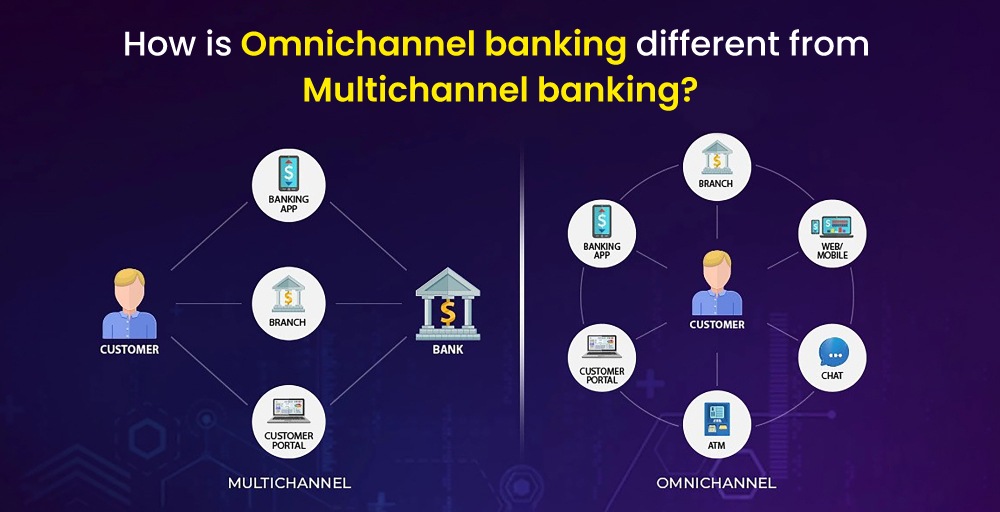
A credit union member can, for instance, initiate a transaction on their banking app, run into trouble, or go to their local branch to resolve the issue, only to discover they have to start over from scratch by explaining the problem to the teller again.
Omnichannel banking offers the same capabilities to members and consumers and enables smooth transitions across interfaces. In the same hypothetical scenario, a credit union member initiates a transaction on their app, runs into trouble, goes to their local branch, and discovers that by entering their account number, the teller can see all of their recent activity, not just their transaction history.
After that, the member can continue their transaction where they left off, making banking considerably easier and less complicated.
| Features | Omnichannel banking | Multichannel banking |
| Focus | Customer-centric | Bank-centric |
| Goal | Unified experience across all channels | Offer multiple ways to bank |
| Channel integration | Seamless integration between channel | Channels function independently |
| Customer data | Single view of customer data across channels | Data may be siloed by channel |
| User experience | Consistent experience regardless of channel | Experience may vary by channel |
| Security | Increased focus on security due to data flow | Security considerations may be channel-specific |
| Example | Applying for a loan can be started online and completed in-branch with all necessary documentation in hand. | Repeating information when transferring between online chat assistance and phone banking |
What are some of the leading omnichannel banking solutions available today?
Omnichannel banking solutions are software and technology packages designed to help banks implement an omnichannel banking strategy. Typically, these solutions tackle the multiple issues associated with omnichannel banking and offer functionalities that combine disparate channels into a harmonious whole.
Here is a breakdown of what omnichannel banking solutions typically offer:
Channel integration
The primary purpose is seamlessly integrating all financial channels, including ATMs, branches, internet banking, and mobile apps. This will allow data to be shared in real time and provide consistent information access across all touchpoints.
Customer data management
Omnichannel banking systems frequently include a customer data platform that collects customer data from all interactions. This platform offers a consolidated picture of every client, enabling targeted marketing and individualized service.
User experience management
These solutions support the management and design of the user experience via all media. This guarantees that the web platform, ATMs, branch interfaces, mobile app, and online platform have the same appearance, feel, and functionality.
Security features
Omnichannel banking solutions prioritize data security and come with strong security safeguards to safeguard client information on all platforms. This might include encryption and multi-factor authentication features.
Analytics and Reporting
Analytics technologies that monitor client behavior and interaction across channels are available in many systems. Banks can better understand client preferences and their omnichannel strategies using this data.
What are the key components of omnichannel banking?
Omnichannel banking hinges on a few key elements working together to create a unified customer experience across various touchpoints. Let’s dive into its key components:
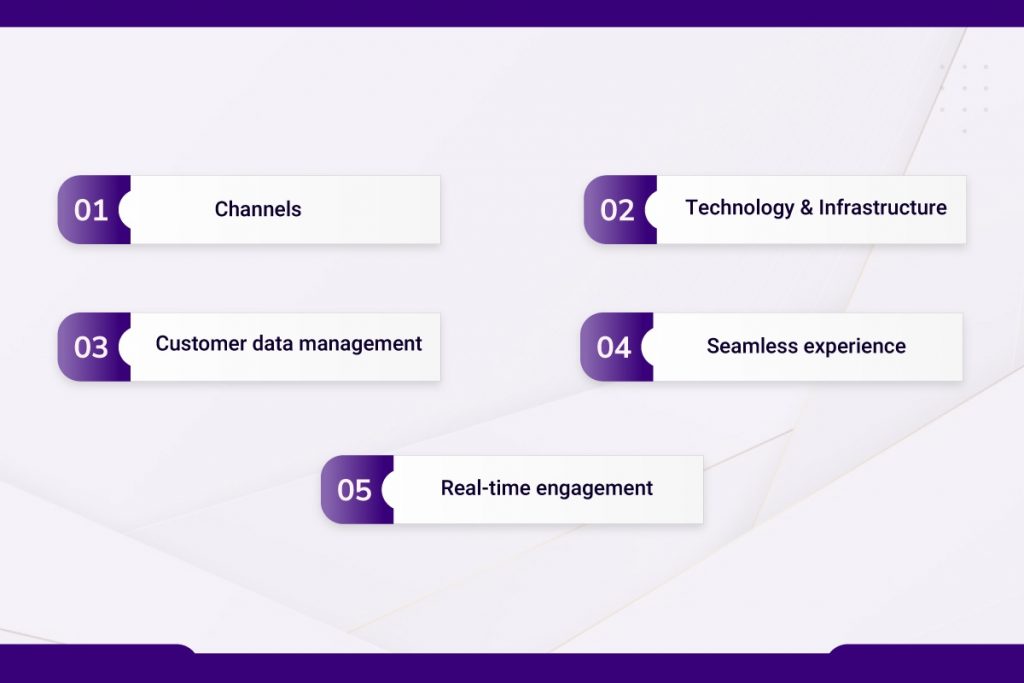
Channels
This introduces the various methods clients can use to communicate with the bank. These include digital channels like mobile applications, online banking platforms, and social media, as well as conventional channels like branch locations, ATMs, and phone banking.
Technology & Infrastructure
Everything has to work together seamlessly, which requires a solid technological foundation. A system that smoothly combines all the channels is necessary to enable real-time data transmission and uniform information access across touchpoints.
Customer data management
Customer understanding is at the heart of multichannel banking. This calls for creating a single, comprehensive customer data platform that compiles data from all interactions and provides a whole picture of every client’s banking experience.
Seamless experience
Customers want a consistent experience regardless of the channel they utilize. To achieve this, uniform branding, usability, and functionality across all media must be ensured. You also want to seamlessly transition between channels while they’re working on something else.
Real-time engagement
Real-time engagement is essential to omnichannel banking. This might include choices for live chat with customer support agents, tailored alerts, or interactive chatbots for simple questions.
What are the challenges of implementing omnichannel banking?
Although omnichannel banking has many benefits for banks and clients, its implementation must address obstacles. These are a few of the major challenges.
Technical hurdles
A strong technical infrastructure is needed to ensure that all the various channels such as mobile applications, internet banking, and physical branches to interoperate seamlessly. Banks can find it costly to adopt and manage this, particularly if they have older legacy systems.
Data integration
Omnichannel banking means having a single view of the customer across all channels. The process of doing this requires a complex and time-consuming integration of data from all these many sources.
Consistent user experience
Customers expect a seamless and consistent experience no matter how they bank with you. To do this, ensure every channel has the same appearance, feel, and capabilities.
Security concerns
There is a greater chance of security breaches when increased data moves across more channels. To safeguard client data, banks must implement strong security procedures.
Cultural shift
A change in bank culture from compartmentalized divisions to a more team-oriented approach is necessary for omnichannel banking. For certain banks, this can be problematic.
What are the latest omnichannel banking trends?
The omnichannel banking world constantly evolves to meet customer expectations and stay ahead of the curve. Here are some of the trends to watch:
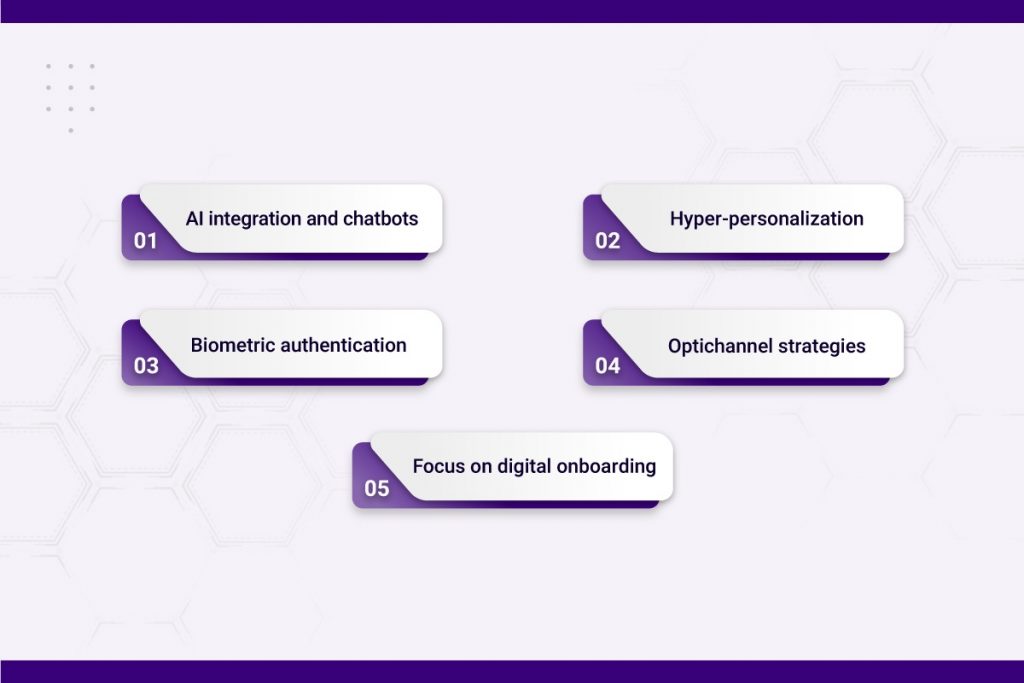
AI integration and chatbots
Banks are increasing the use of artificial intelligence (AI) to power chatbots that can provide instant customer support, quick response, personalized recommendations, and efficient query resolution.
Hyper-personalization
Data analytics provides ultra-personalized experiences. This entails providing personalized financial insights, focused product suggestions, and proactive money management solutions according to each client’s particular circumstances.
Biometric authentication
Biometric authentication techniques, such as face scanning and fingerprint identification, are being increasingly commonly used in a variety of banking channels to improve security and customer experience.
Optichannel strategies
While omnichannel emphasizes providing every channel, other organizations are implementing optichannel, a more calculated strategy. This entails determining which channels are most pertinent for a certain client category and enhancing the experience on those channels.
Focus on digital onboarding
Banks are expediting the account opening process by using fully digital onboarding experiences with a focus on convenience. This lessens dependency on physical branches and enables speedier client acquisition.
Conclusion
Omnichannel banking seamlessly integrates various customer touchpoints, such as online, mobile, and in-person interactions, ensuring a consistent user experience. It enhances customer satisfaction, personalization, and flexibility while reducing costs through streamlined operations. Unlike multichannel banking, omnichannel banking enables smooth transitions across interfaces, fostering trust and human connection.
Leading solutions offer channel integration, customer data management, user experience enhancement, security features, and analytics. Key components include channels, technology, customer data management, seamless experience, and real-time engagement. Challenges include technical hurdles, data integration, consistent user experience, security concerns, and cultural shifts. Trends include AI integration, hyper-personalization, biometric authentication, omnichannel strategies, and digital onboarding.
FAQ
Is omnichannel banking safe?
Yes, if done properly, omnichannel banking can be secure. Security precautions are essential to safeguard consumer information and transactions. Banks invest significantly in monitoring systems, strong authentication procedures, and encryption to guarantee security via all channels. Customers must, however, adhere to recommended practices, which include creating secure passwords, avoiding sensitive transactions over public Wi-Fi, and reporting any suspicious behavior right once.
Can I use omnichannel banking to deposit checks remotely?
Of course! Several banks provide online or mobile apps for remote check deposits. Consumers can scan their checks using a camera and submit them online. This helpful function removes the need to visit a real branch and saves time.
Can I schedule appointments with my banker through omnichannel banking?
Absolutely, some banks provide tools for arranging appointments from inside their omnichannel systems. Through the bank’s website or app, clients can schedule meetings with bankers, financial advisors, and other professionals. This guarantees individualized support at a suitable moment.
Can I get help with my finances through omnichannel banking?
Of course! Omnichannel banking allows customers to access a range of financial services and resources. Through chat, phone, or video sessions, customers can ask for assistance with basic economic questions, loan applications, investment advice, and budgeting. Banks frequently offer resources and instructional materials to improve financial literacy.

